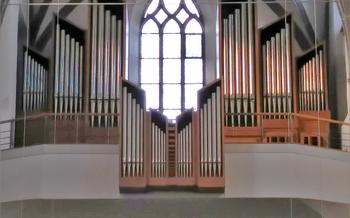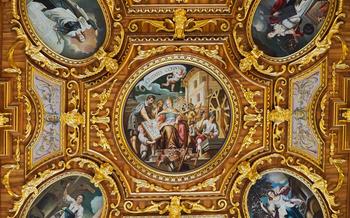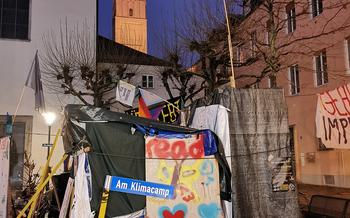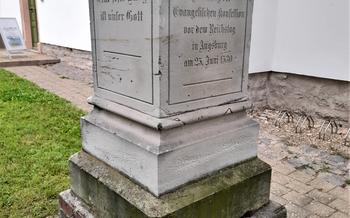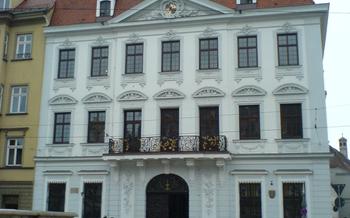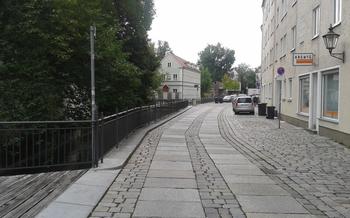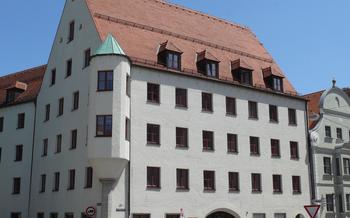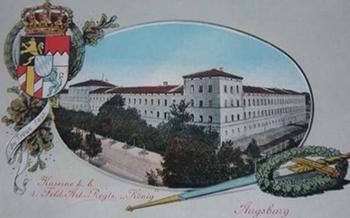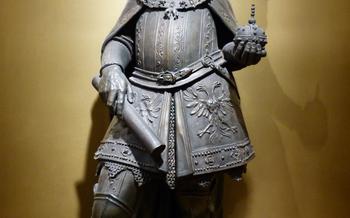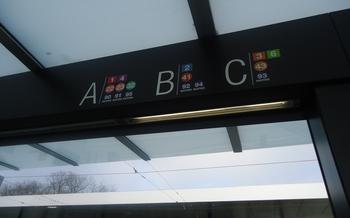
Eiskeller
- Eiskeller: A Historical Landmark in Augsburg
- Renaissance Architecture: A Glimpse into the Past
- Augsburg's Ice Age: The Origin of the Eiskeller
- A Cold War Relic: The Eiskeller's Secret Role
- Exploring the Eiskeller: A Guided Tour
- Step Back in Time: The Eiskeller Museum
- The Eiskeller's Cultural Significance
- Practical Information: Planning Your Visit
- Unique Features of the Eiskeller
- Augsburg's Rich History: Beyond the Eiskeller
- The Eiskeller's Role in Augsburg's Tourism
- Ecological Importance of the Eiskeller
- The Eiskeller's Legacy: A Living Monument
- Insider Tip: Hidden Gems Near the Eiskeller
Eiskeller: A Historical Landmark in Augsburg
Augsburg's Eiskeller, a subterranean marvel dating back to the 17th century, stands as a testament to the city's rich history and architectural ingenuity. Once used for storing ice to cool food and beverages, this remarkable structure has evolved into a cultural landmark of immense significance. Its unique architectural features, meticulous preservation efforts, and enduring cultural heritage make the Eiskeller a must-visit destination for anyone seeking to delve into Augsburg's past and appreciate its enduring charm.
Historical Significance
The Eiskeller's origins can be traced back to the early 17th century when Augsburg, a thriving city renowned for its trade and commerce, faced the challenge of preserving food and beverages during the hot summer months. In response to this need, the city fathers commissioned the construction of the Eiskeller, a subterranean storage facility designed to keep ice cool throughout the year.
The Eiskeller's construction involved excavating a series of interconnected chambers deep into the earth, creating a naturally cool and humid environment ideal for preserving ice. The thick stone walls and vaulted ceilings provided insulation, ensuring that the ice remained frozen even during the warmest months.
Architectural Features
The Eiskeller's architectural design is a testament to the ingenuity of its builders. The subterranean chambers are interconnected by a network of tunnels and staircases, creating a labyrinthine structure that adds to its allure. The walls are lined with niches and recesses, where blocks of ice were once stored.
The Eiskeller's entrance is adorned with a magnificent Renaissance-style portal, featuring intricate carvings and sculptures that hint at the building's historical significance. The portal leads to a grand staircase that descends into the depths of the Eiskeller, creating a sense of anticipation and awe.
Preservation Efforts
Recognizing the Eiskeller's historical and cultural significance, the city of Augsburg has undertaken extensive preservation efforts to ensure its longevity. The structure has been meticulously restored, with careful attention paid to retaining its original features while incorporating modern safety and accessibility measures.
The Eiskeller's transformation into a cultural landmark has been a testament to the city's commitment to preserving its heritage. Today, it stands as a symbol of Augsburg's rich past and a reminder of the ingenuity and craftsmanship of its people.
Renaissance Architecture: A Glimpse into the Past
Augsburg's rich architectural heritage is exemplified by its numerous Renaissance-style buildings, which stand as testaments to the city's prosperity and artistic achievements during the 16th and 17th centuries. This architectural style, characterized by its symmetry, proportion, and classical motifs, originated in Italy and spread throughout Europe during the Renaissance period.
The Rathaus, or Town Hall, is a prime example of Renaissance architecture in Augsburg. Built in the early 17th century, this imposing edifice features an elegant facade adorned with intricate carvings, sculptures, and a beautifully painted gable. The Golden Hall, located within the Rathaus, is renowned for its opulent interior, adorned with ornate stucco work, frescoes, and a magnificent ceiling painting.
Another notable example of Renaissance architecture in Augsburg is the Fuggerei, the world's oldest social housing complex. Founded by the wealthy Fugger family in the 16th century, the Fuggerei consists of over 140 small houses arranged in narrow streets, creating a unique and charming historical neighborhood. The buildings showcase Renaissance architectural elements, such as gabled roofs, decorative facades, and intricate doorways.
These Renaissance-style buildings not only enhance Augsburg's cityscape but also serve as a reminder of the city's significant contribution to the development of European architecture. They continue to inspire and captivate visitors, providing a glimpse into the artistic and cultural achievements of a bygone era.
Augsburg's Ice Age: The Origin of the Eiskeller
The Eiskeller's existence is intrinsically linked to Augsburg's unique geological history. During the last ice age, approximately 10,000 years ago, massive glaciers carved out the landscape, leaving behind a series of depressions that eventually filled with water, forming lakes and ponds. One such body of water, known as the Goggelesbach, meandered through the area where the Eiskeller now stands.
As the climate warmed, the Goggelesbach gradually receded, leaving behind a thick layer of sediment and debris. This natural process created an insulating blanket that allowed ice to form and persist throughout the year, even during the summer months. The locals quickly recognized the potential of this natural refrigeration and began to harvest and store ice in the underground chambers, giving rise to the Eiskeller.
The ice harvesting process was a laborious and time-consuming task. During the winter months, workers would cut large blocks of ice from the frozen ponds and transport them to the Eiskeller using horse-drawn sleds. The ice blocks were then stored in the underground chambers, where the constant cool temperatures ensured their preservation. This ice was a valuable commodity, used to preserve food and beverages, particularly during the hot summer months.
A Cold War Relic: The Eiskeller's Secret Role
During the Cold War, the Eiskeller took on a new and chilling significance. Its thick walls and isolated location made it an ideal air raid shelter, capable of withstanding the impact of a nuclear bomb. The Eiskeller was equipped with essential supplies, such as food, water, and medical kits, to sustain a large number of people for an extended period.
Classified documents reveal that the Eiskeller was designated as a strategic military site, known only to a select few. In the event of a nuclear attack, high-ranking government officials and military personnel would have sought refuge in the Eiskeller. The secrecy surrounding its military role ensured that the Eiskeller remained largely unknown to the public until after the fall of the Berlin Wall.
Today, the declassification of these documents has shed light on the Eiskeller's Cold War past. Visitors to the Eiskeller can learn about its role as an air raid shelter and gain a deeper understanding of the tensions and fears that shaped this era. The preservation of the Eiskeller serves as a reminder of the fragility of peace and the importance of international cooperation to prevent future conflicts.
Exploring the Eiskeller: A Guided Tour
Immerse Yourself in History and Mystery
To fully appreciate the Eiskeller's unique character and significance, consider embarking on a guided tour. These tours provide an immersive experience, transporting you back in time as you explore the Eiskeller's hidden chambers and learn about its fascinating history.
Guided Tour Highlights
During the tour, you will be captivated by the Eiskeller's remarkable features, including its intricate underground chambers, natural ice formations, and exceptional acoustics. You will also learn about the Eiskeller's role in Augsburg's ice trade, its military significance during the Cold War, and its eventual transformation into a museum.
Duration, Pricing, and Availability
Guided tours of the Eiskeller are typically offered daily, with varying schedules depending on the season. The tours usually last around 45 minutes to an hour and are conducted in both German and English. Ticket prices are reasonable, catering to visitors of all budgets.
Booking Information
To ensure a spot on a guided tour, it is advisable to book in advance, especially during peak tourist season. Reservations can be made online or by phone through the Augsburg Tourism Office. Online booking is recommended for convenience and to secure your preferred time slot.
Step Back in Time: The Eiskeller Museum
The Eiskeller Museum, housed within the historic Eiskeller, offers a fascinating glimpse into the past. Through interactive exhibits, historical artifacts, and educational programs, visitors can delve deep into the ice cellar's rich history and cultural significance.
The museum's exhibits showcase the Eiskeller's role in ice harvesting and storage, its military use during the Cold War, and its subsequent transformation into a cultural landmark. Visitors can learn about the geological formation of the ice cellar, its impact on Augsburg's economy, and the unique challenges of preserving this subterranean treasure.
Among the highlights of the museum are authentic ice tools, photographs, and documents that provide a glimpse into the daily lives of the ice workers who toiled in the Eiskeller. Interactive displays allow visitors to experience the sensation of being inside an ice chamber and to learn about the science behind the Eiskeller's natural cooling system.
The Eiskeller Museum is a valuable resource for anyone interested in Augsburg's history, culture, and architecture. Through its engaging exhibits and educational programs, the museum helps to preserve the legacy of the Eiskeller and to ensure that its story continues to inspire future generations.
The Eiskeller's Cultural Significance
The Eiskeller's rich history and unique characteristics have imbued it with significant cultural value, making it a beloved landmark in Augsburg. It stands as a symbol of resilience, having withstood the trials of time and the ravages of war. The Eiskeller has become a source of pride for the local community and has been immortalized in local folklore, art, and literature. Its captivating story has inspired countless artists, writers, and musicians, who have found inspiration in its timeless beauty and intriguing history. The Eiskeller's cultural significance has been recognized on a global scale, earning it a prestigious spot on the UNESCO World Heritage List. This designation serves as a testament to the Eiskeller's outstanding universal value and its importance as a cultural treasure to be preserved and cherished for generations to come.
Practical Information: Planning Your Visit
Before embarking on your journey to the Eiskeller, it's essential to plan your visit to make the most of your experience. The Eiskeller is open to the public during specific hours, and admission fees apply. Check the official website or contact the tourist information center for up-to-date information on opening hours and admission prices.
Getting to the Eiskeller is easy, as it is situated in the city center of Augsburg. Various public transportation options are available, including buses and trams, which will take you within walking distance of the landmark. For those arriving by car, there are nearby parking facilities.
Guided tours are highly recommended for a comprehensive and insightful experience. These tours are offered at a nominal fee and provide an in-depth look into the history, architecture, and significance of the Eiskeller. Reservations for guided tours can be made in advance online or by phone.
To make your visit even more memorable, consider exploring the surrounding area. The Eiskeller is situated in the historic heart of Augsburg, with many other attractions, restaurants, and shops nearby. Take advantage of this opportunity to immerse yourself in the city's rich culture and heritage.
Unique Features of the Eiskeller
One of the most fascinating aspects of the Eiskeller is its unique features that set it apart from other historical landmarks. The underground chambers, built deep beneath the city, offer a glimpse into a hidden world of ice and stone. The natural ice formations, created by the constant freezing and thawing of water, are a sight to behold. The acoustic properties of the Eiskeller are also remarkable, creating a reverberant atmosphere that has made it a popular venue for concerts and performances. In addition, the Eiskeller has been used as a backdrop for art installations and contemporary exhibitions, showcasing the building's versatility and adaptability.
Augsburg's Rich History: Beyond the Eiskeller
Augsburg is a city steeped in history, boasting a wealth of cultural treasures beyond the Eiskeller. The Fuggerei, founded in 1516, is the world's oldest social housing complex, providing a glimpse into the lives of ordinary Augsburgians from centuries past. The Augsburg Cathedral, a masterpiece of Gothic architecture, stands as a testament to the city's religious significance. For art enthusiasts, the Kunstmuseum Augsburg houses a remarkable collection of paintings, sculptures, and decorative arts from across the centuries.
Augsburg's cultural heritage is further enriched by its vibrant festivals and events. The Augsburg High Renaissance Festival, held annually, celebrates the city's golden age with music, theater, and historical reenactments. The Augsburg Christmas Market, one of Germany's largest and oldest, transforms the city into a winter wonderland, with twinkling lights, festive decorations, and the scent of mulled wine filling the air.
Augsburg's rich history is deeply intertwined with the stories of its people. From the Fugger family, who rose from humble beginnings to become one of Europe's most powerful dynasties, to Bertolt Brecht, the renowned playwright and poet who was born in Augsburg, the city's past is filled with fascinating characters and events.
Whether exploring its architectural wonders, delving into its artistic treasures, or immersing oneself in its vibrant cultural scene, Augsburg offers a captivating journey through time, inviting visitors to discover the many layers of its rich and storied past.
The Eiskeller's Role in Augsburg's Tourism
Augsburg's Eiskeller has emerged as a prominent tourist attraction, drawing visitors from across the globe. Its unique blend of history, architecture, and cultural significance has positioned it as a must-visit destination for those seeking an immersive experience in the city's rich heritage. The Eiskeller's contributions to the local economy are substantial, generating revenue through ticket sales, guided tours, and associated tourism activities.
The Eiskeller's popularity extends beyond its historical significance, as it also serves as a versatile venue for various events and activities. Throughout the year, the Eiskeller hosts an array of seasonal events, concerts, performances, workshops, and educational programs that cater to diverse interests and age groups. These events not only enhance the Eiskeller's appeal but also contribute to the city's vibrant cultural scene.
Augsburg's commitment to promoting its cultural heritage is exemplified by the Eiskeller. Its inclusion on the UNESCO World Heritage List further underscores its global significance, attracting international recognition and contributing to Augsburg's reputation as a cultural hub. The Eiskeller epitomizes the city's efforts to preserve and celebrate its past while simultaneously embracing sustainable tourism practices.
In conclusion, the Eiskeller plays a pivotal role in Augsburg's tourism industry, serving as a major attraction, contributing to the local economy, promoting cultural heritage, and fostering sustainable tourism practices. Its unique appeal and historical significance continue to captivate visitors, making it an integral part of Augsburg's tourism landscape.
Ecological Importance of the Eiskeller
Beyond its historical and cultural significance, the Eiskeller also holds ecological importance. The unique microclimate within the underground chambers has created a natural habitat for various species of plants and animals, some of which are rare or endangered. The Eiskeller's constant temperature and humidity provide a stable environment for these organisms to thrive.
Conservation efforts are underway to protect the diverse ecosystem within the Eiskeller. Researchers and biologists regularly monitor the flora and fauna, ensuring their well-being and conducting studies to understand the unique ecological processes at play. Educational programs are also organized to raise awareness about the Eiskeller's ecological significance and promote sustainable practices.
By preserving the Eiskeller's natural environment, we not only safeguard its historical and cultural heritage but also contribute to the conservation of biodiversity and the promotion of sustainability. The Eiskeller serves as a reminder of the delicate balance between human history and the natural world, highlighting the importance of responsible stewardship for future generations.
The Eiskeller's Legacy: A Living Monument
The Eiskeller continues to hold a special place in the hearts of Augsburg's residents and visitors alike. Its unique blend of historical significance, architectural beauty, and cultural heritage has cemented its status as a beloved landmark. Ongoing preservation efforts ensure that the Eiskeller remains a living monument, adapting to modern needs while preserving its historical integrity.
The city of Augsburg recognizes the importance of striking a balance between preserving the Eiskeller's legacy and embracing progress. Careful restoration and renovation projects aim to maintain the building's original character while introducing modern amenities and technologies. This delicate balancing act ensures that the Eiskeller remains accessible and relevant to future generations.
Adaptive reuse has played a crucial role in revitalizing the Eiskeller. Once a symbol of resilience and innovation, the Eiskeller now serves as a multi-faceted cultural venue. Its underground chambers host a variety of events, from concerts and performances to workshops and educational programs. This transformation has breathed new life into the Eiskeller, making it a vibrant hub for cultural exchange and community engagement.
The Eiskeller's enduring legacy lies in its ability to adapt and evolve while remaining true to its roots. As Augsburg continues to grow and change, the Eiskeller stands as a reminder of the city's rich history and its commitment to preserving its cultural heritage. The ongoing efforts to maintain and revitalize the Eiskeller ensure that this iconic landmark will continue to captivate and inspire visitors for generations to come.
Insider Tip: Hidden Gems Near the Eiskeller
Venturing beyond the Eiskeller, Augsburg unveils a treasure trove of hidden gems waiting to be discovered. Just a short stroll away, immerse yourself in the tranquility of the Botanical Garden, a verdant oasis showcasing a diverse collection of plant life. For a taste of local history, delve into the fascinating exhibits at the Swabian Museum, which chronicles the rich heritage of the region.
Indulge in culinary delights at one of the charming cafes nestled along the picturesque streets near the Eiskeller. Savor traditional Bavarian specialties or sample contemporary cuisine crafted with fresh, local ingredients. For a unique shopping experience, explore the boutiques and specialty shops lining the cobblestone alleys, where you can find handcrafted souvenirs, vintage treasures, and locally designed fashion.
Uncover the hidden stories of Augsburg by venturing off the beaten path. Discover the secrets of the medieval city walls, stumble upon hidden courtyards adorned with vibrant street art, or immerse yourself in the lively atmosphere of the local markets, where vendors showcase their artisanal products and fresh produce.
Augsburg's hidden gems offer a glimpse into the city's multifaceted character. Whether you seek historical charm, culinary adventures, or unique shopping experiences, this vibrant city has something to offer every curious traveler. Embrace the spirit of discovery and uncover the hidden treasures that await around every corner.
